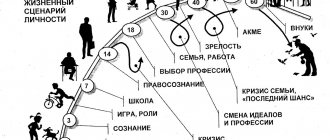Personal socialization is the process of integrating a person into the social system by mastering norms, rules, skills and knowledge that will help him function normally in society. If the behavior of animals is determined by instincts, then a person needs socialization for normal life.
In the online program “Self-Knowledge” you will be able to find out your characteristics, strengths and weaknesses and adjust the vector of your development.
Types and agents of socialization.
Socialization
is the process of an individual’s assimilation of patterns of behavior, psychological attitudes, social norms and values, knowledge, and skills that allow him to function successfully in society, beginning in infancy and ending in old age.
Types of socialization: 1. Primary socialization
. This stage covers the process of formation and development of personality, that is, the process of caring for, raising and educating children primarily in the family, carried out by those agents of socialization who are in direct and regular contact with the child in early and late childhood. During primary socialization, passive assimilation of information, skills, and ideas predominates.
2. Secondary socialization.
This stage covers the rest of the person’s “adult” life. At this stage, the development of the social environment occurs consciously, most of the information coming from outside is subjected to critical consideration. The individual makes a meaningful choice from several options.
3 Early socialization
represents a “rehearsal” for future social relations. For example, a young couple may live together before marriage in order to have an idea of what family life will be like.
4. Resocialization
is re-socialization that occurs throughout an individual's life. Resocialization is carried out by changes in the individual’s attitudes, goals, norms and values of life
5. Organizational socialization
is the process by which an individual acquires the values, abilities, norms of behavior and social outlook that are important for gaining weight in the organization and full participation in it as an employee
6. Group socialization
is socialization within a specific social group. Group socialization is the process of inculcating ideas and principles into an individual as he internalizes the basic values and symbols of the group in which he is involved.
7. Gender socialization
- this is the assimilation, internalization of social roles, differentiation of activities, statuses, rights and responsibilities of individuals depending on gender.
9 pages, 4458 words
GOALS, SUBJECT, TASKS OF THE EDUCATIONAL PROCESS, TYPES AND TYPES ...
... actions provided for by law. GOALS, SUBJECT, OBJECTIVES OF THE EDUCATIONAL PROCESS, TYPES AND TYPES OF EDUCATIONAL PROGRAMS IMPLEMENTED 2.1. The school operates in accordance with ... and the formation of the student’s personality, his inclinations, interests and abilities for social self-determination. Basic general education is the basis for obtaining secondary general...
Agents of Socialization
- these are structural groups or environments in which the most important processes of socialization take place. In all cultures, the most important agent of primary socialization for a child is the family. However, in later stages of life, many other agents of socialization come into play. Agents of secondary socialization of an individual are school, university, army, church.
Peer groups, the media, mass printed publications, and electronic communications have a great socializing effect on a person.
What does it contribute to?
Socialization and adaptation make it possible to form in a person’s brain the necessary set of values and rules that he will subsequently apply to the world. These processes begin in childhood, when the parents of a young child begin to lay the foundation for the first mental and physical skills. After this, the person undergoes training in kindergarten, school and college. During this period, he gains more knowledge from other people, continuing to explore the world. Thanks to this, a person learns to communicate with the individuals around him and understands that the form of interaction with them can be different.
In addition, the socialization of the child is very important, as it teaches him self-control. Gradually, a person begins to learn how to react to certain events in his life. Thanks to this, he learns to distinguish between the internal and external worlds.
Stages of personality socialization
There are several stages of personality socialization:
Primary socialization, or adaptation stage
(from birth to adolescence, the child uncritically assimilates social experience - adapts, adapts and imitates).
Individualization stage
(adolescence and early adolescence).
During this period, there is a desire to distinguish oneself from others, and a critical attitude towards social norms of behavior appears. In adolescence, the stage of individualization, self-determination “the world and I” acts as an intermediate socialization, since the inner world of a teenager is characterized by instability. In general, adolescence is characterized as stable conceptual socialization, during which stable personality traits are developed.
Integration stage
a desire is manifested to find one’s place in society, to “fit in” with society. Integration goes well only if a person’s properties are accepted by the group, by society. If they are not accepted, then the following outcomes are possible: - maintaining one’s dissimilarity and the emergence of aggressive interactions (relationships) with people and society; - changing yourself to “become like everyone else”; - conformism, external agreement, adaptation.
Labor stage
socialization covers the entire period of a person’s maturity, his work activity, when a person reproduces social experience by influencing the environment through his activities.
Post-labor stage
socialization covers old age, when a significant contribution is made to the reproduction of social experience, to the process of transferring it to new generations.
Material Fixation Test
- 1Socialization of the individual is:
- The process by which certain social patterns are formed from birth
- The process as a result of which each individual enters society and from this changes occur, both in the person himself and in the social group
- The process by which each individual learns moral and cultural norms
- 2How many stages of personality socialization according to Erik Erikson are there?
- Five
- Seven
- Eight
- 3Who is part of the main group of people at the initial stages of socialization?
- Relatives and friends
- Friends and controls
- Schools, universities, and other large-scale enterprises
- 4What problem may an individual have when entering society?
- Ignorance of behavioral norms
- Difficulties with adaptation, problems with changing oneself
- Adaptability problems, low activity
- 5At what stage of socialization does a child begin to understand that he is a separate person?
- At the preschool stage
- At the early childhood stage
- During my school years
Question 1 of 5
Question 2 of 5
Question 3 of 5
Question 4 of 5
Question 5 of 5
Problems of personality socialization.
Every society is objectively interested in the reproduction of its value system, in its transmission from generation to generation. This is the key to the stability and sustainability of society, the spiritual unity of generations. Problems of social values thus appear as problems of coordinating the value orientations of an individual with the value system of a given society.
Changes in the starting capabilities of young people predetermined the characteristics of the social development of the younger generation in the conditions of the formation of market relations. An integrative characteristic of the social status of young people within the entire socio-demographic group allows us to highlight some features of the socialization of the younger generation of modern society. Among them:
10 pages, 4906 words
Problems of socialization of modern youth
... manifested itself in the fact that in the study of the process of socialization of new generations, the emphasis is still placed on the targeted influence on youth from institutions, on the development of methodological instructions for education... He is characterized by both the material that he learns and the origin of this material. In the personality of the philosopher there is time, its movement, its problematics, the forces of time are unusually...
— gap in the education and upbringing system;
— deformation of the principle of continuity of generations;
— increasing trends in the reproduction of the sick generation as a result of the threatening health status of young people;
- purposeful destruction of the individual, citizen, patriot.
On the part of society, social institutions have the greatest impact on the formation of value orientations of young people. So, in the 90s. There is a transformation of the family, leading to a decrease in the level of implementation of its socialization function.
There is a transformation of the socialization function of the education system, manifested in a decrease in its role in ensuring the integration of young people into society, as well as in educating the younger generation. The foundations of the educational system are also undermined by the fact that about half of all types of professions for which training is carried out in educational institutions are not required in the labor market.
The impact of telecommunications today is assessed as both negative and positive. On the one hand, the commercialization of television channels leads to the predominance on television screens of low-quality Western films, full of violence, aggression, brutality, and sex. On the other hand, the emergence of new types of television programs helps young people both in their studies and in broadening their horizons, opening up completely new horizons of knowledge. A new type of information field permeates all spheres of social life, affecting socialization processes in various institutions of socialization.
The impact of telecommunications today is assessed as both negative and positive. On the one hand, the commercialization of television channels leads to the predominance on television screens of low-quality Western films, full of violence, aggression, and cruelty. On the other hand, the emergence of new types of television programs helps young people both in their studies and in broadening their horizons, opening up completely new horizons of knowledge.
Social deviation: concept, types.
Social deviation
- social behavior that deviates from accepted, socially acceptable behavior in a particular society.
There are many types of social deviation.
Cultural and psychological deviation
(By the nature of deviations)
Cultural deviance is behavior that deviates from cultural norms. Studied by sociologists. Psychological deviation is deviations in the personal organization: psychotics, neurotics, paranoids, etc. These deviations are studied by psychologists.
Individual and group deviation
(By subject type)
Thus, there are two pure types of deviants:
1) individual deviants
deny the norms that surround them. For example, a teenager who grew up in an intelligent family and becomes a drug addict, thereby demonstrating individual deviation.
2) group deviants
are conformists within deviant groups. For example, Children raised in alcoholic families who subsequently become part of a homeless group where substance abuse is commonplace exhibit group deviance.
Primary and secondary deviation
.(By degree of significance)
Primary deviation
- this is a type of behavior that generally corresponds to cultural norms; it is a minor, tolerant, acceptable deviation.
14 pp., 6869 words
The role of gender identity in the manifestation of deviations in behavior
...success and its achievement. Following them strengthens the structural differentiation of society, which leads to conflicts and deviant behavior. S. de Grazia introduces the distinction between “simple” and “acute”... identifies three components of deviation [25, p. 121]: 1) a person who is characterized by a certain behavior; 2) norm (expectation), which is a criterion for assessing deviant behavior 3) some other person, ...
Secondary deviation
- a process during which, after the act
primary deviation, a person, under the influence of public reaction, accepts
deviant identity, that is, it is reconstructed as a person from the standpoint of that
group to which he was assigned.
Positive and negative deviation.(
By negativity)
Positive deviation
– deviations from the norms that are encouraged in a given society.
A genius, a hero, a spiritual leader are positive deviants. Although positive deviation occurs in any society, negative deviation attracts the greatest attention from sociologists .
Negative deviation
- behavior that is condemned by society and entails punishment. Criminals, drug addicts, alcoholics, prostitutes are negative deviants.
Desocialization
The concept of desocialization of the individual is closely related to resocialization, and means the destruction of previously mastered and accepted norms and rules of behavior, the destruction of previous attitudes.
What is it and why is this process needed? This process is used by psychologists when a person’s learned norms of behavior prevent him from successfully fitting into society. In this case, a person must desocialize - abandon previous attitudes, and then resocialize - accept new rules of behavior adopted in the group.
Desocialization is necessary for victims of domestic violence, people who went through wars and lived in combat zones, as well as those who moved to other countries with a different cultural heritage or when re-educating individuals suffering from deviant behavior - alcoholics, drug addicts, criminals. “Reconfiguration” of the head in such cases is necessary, and the process plan usually begins with an assessment of the attitudes that the individual sees as unshakable, and proof that this unshakability is apparent.
The causes of deviation in the concepts of Ch. Lombroso, H. Sheldon, Z. Freud.
The reason for deviant behavior may lie in the structural features of the human body. The most famous supporters of these ideas are C. Lombroso and W. Sheldon. The Italian doctor C. Lombroso believed that a tendency to criminal behavior can be determined by such characteristic features as a protruding lower jaw, a sparse beard and reduced sensitivity to pain.U. Sheldon believed that a certain body structure meant the presence of characteristic personality traits. An endomorph (a person of moderate obesity with a soft and somewhat rounded body) is characterized by sociability, the ability to get along with people and self-indulgence. The mesomorph (whose body is strong and slender) tends to be restless, active and not overly sensitive. An ectomorph (distinguished by the thinness and fragility of the body) is prone to introspection, endowed with increased sensitivity and nervousness. Based on studies of the behavior of two hundred young men, Sheldon concluded that mesomorphs are most prone to deviation, although they do not always become criminals. In accordance with another biological concept, men who have an additional Y chromosome are more prone to display deviation than others, but a clear cause-and-effect relationship between the presence of aberrant chromosomes and deviation has not been identified.
The psychological approach sees the cause of deviation in psychological conflicts, problems and traumas, especially those experienced by the individual in childhood. The most famous is the psychoanalytic theory of S. Freud. Deviant behavior, according to Z. Freud, arises as a result of a conflict between Ego and Id or Superego and Id. For example, crimes arise when the Superego - the individual's civilized self-control - cannot cope with the primitive, destructive, cruel impulses of the Id. Various impulses can be suppressed, thereby moving into the unconscious layers of the psyche.
Social anomie: Concepts and causes.
Anomie
- a state of society in which a significant part of its members, knowing about the existence of binding norms, treats them negatively or indifferently, a state of lawlessness.
The phenomenon of social anomie was first described by the French sociologist Emile Durkheim. Anomie
is the absence of law, organization, norms of behavior, their insufficiency. The concept of anomie characterizes a state of society in which disintegration and collapse of the system of norms that guarantee social order occur (E. Durkheim).
4 pp., 1649 words
Expressive behavior
... (hairstyle, clothing) and a low degree of variability (physiognomic components of expression). The psychology of expressive behavior deals with a wide range of means by which a person expresses himself or herself... Moreover, expressive behavior tends to become part of this condition, for example, the stupid antics of an idiot; smile and...
Social anomie indicates that norms of behavior are seriously violated and weakened. Anomie causes a psychological state of the individual that is characterized by a feeling of loss of orientation in life. The reason for anomie is the insufficient development of rules governing the relations between various social functions that are not coordinated with each other. Durkheim believed that socially deviant behavior and crime are completely normal phenomena. If there is no such behavior in society, then it is painfully controlled. When crime is eliminated, progress stops. Crime is the price to pay for social change. A society without crime is unthinkable. For crime is inevitable, ineradicable. And the reason for this is not that people are weak and evil, but that there is an infinite variety of different types of behavior in society.
67. Social conflict: concept and types.
Social conflict
- conflict, the cause of which is disagreement between social groups or individuals with differences in opinions and views, the desire to take a leading position; manifestation of people's social connections.
In the field of scientific knowledge, there is a separate science dedicated to conflicts - conflictology. A conflict is a collision of opposing goals, positions, and views of the subjects of interaction. At the same time, conflict is the most important aspect of interaction between people in society
Depending on which subjects oppose each other, social conflicts are divided into:
Personality conflict
, i.e. a conflict that occurs within a person at the level of individual consciousness.
Interpersonal conflict
, i.e. disagreements between two or more members of one group or more groups.
Intergroup conflict
, i.e. confrontation between several groups.
According to the content of the problems that caused counter-directional actions, they distinguish industrial, family, labor, economic, political, environmental, ideological, spiritual, moral, legal and other conflicts.
According to their functions, conflicts are usually divided into:
Destructive
(disintegrative) - such conflicts destabilize social systems. Internal conflict destroys group society; strikes could put thousands of people out of work and cause serious damage to industry; marital conflicts prevent the union of spouses; and, finally, a nuclear conflict threatens the destruction of all humanity.
Creating Conflicts
– can enhance group interaction. As a result of the conflict, it is possible to quickly introduce a new leader, use new policies and new norms. Conflict may be the only way out of a tense situation. If individual rights are violated in a group, generally accepted norms are violated, then often only conflict leads to achieving balance and relieving tension.
Examples of similar educational works
The role of gender identity in the manifestation of deviations in behavior
... on the following provisions: Deviant or deviant behavior is a stable behavior of an individual, deviating from the most important social norms, causing real damage to society or the individual himself, and also accompanied by his social ...
Problems of deviations in social behavior of an individual in Russian society
... behavior inconsistency between the goals put forward by society and the means of achieving them. According to cultural explanations, deviance results from conflicts between cultural norms. In society there are separate groups, norms...
The influence of socialization defects on the conflict behavior of adolescents
... Sigmund Freud, the main stages in the socialization of the individual are the stages of psychosexual development, during which the “deployment” of a person’s innate properties occurs, but in conflict with the demands of society. According to neo-Freudians, for example...
Socialization of personality. Social conflict. Age structure of society
... attitudes and beliefs, learning socially accepted norms of behavior and communication, life style options, joining groups and interacting with their members as socialization makes sense if initially the individual ...
Gender characteristics of social ideas of young people about gender-role behavior of an individual.
... gender characteristics of social ideas of young people about the sex-role behavior of an individual. A number of representatives of the scientific community have been studying social representations in domestic and foreign psychology: S. Moscovici, J. Bruner, ...
Mechanisms
Every society has socialization mechanisms through which people convey information about social reality to each other. In sociological terms, there are some “translators” of social experience. These are means that transmit accumulated experience from generation to generation, contributing to the fact that each new generation begins to socialize. Such translators include various sign systems, cultural elements, educational systems, and social roles. Socialization mechanisms are divided into two categories: socio-psychological and socio-pedagogical.
Socio-psychological mechanisms:
- Imprinting is the imprinting of information on the receptor and subconscious levels. More common in infancy.
- Existential pressure - the assimilation of language and norms of behavior at an unconscious level.
- Imitation is following a model, voluntary or involuntary.
- Reflection is an internal dialogue during which a person critically thinks about and then accepts or rejects certain social values.
Social and pedagogical mechanisms:
- Traditional - a person’s assimilation of prevailing stereotypes, which occurs, as a rule, at an unconscious level.
- Institutional - triggered by a person’s interaction with various institutions and organizations.
- Stylized - functions when included in any subcultures.
- Interpersonal - turns on whenever there is contact with persons who are subjectively significant to a person.









